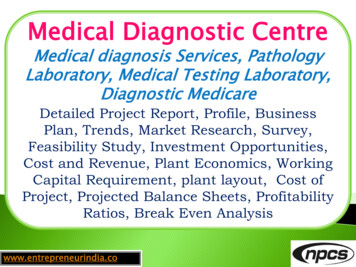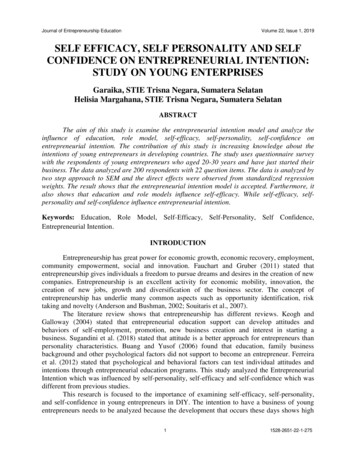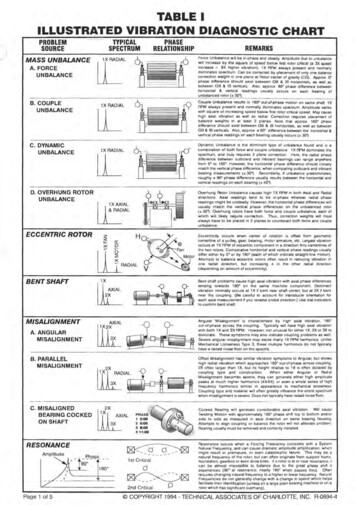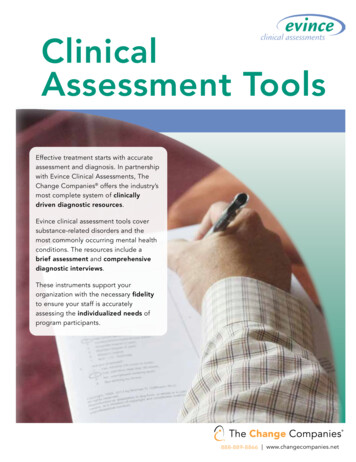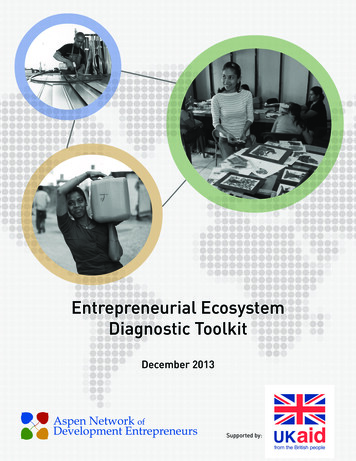
Transcription
Entrepreneurial EcosystemDiagnostic ToolkitDecember 2013Supported by:
Table of ContentsIntroduction.1Studying the Entrepreneurial Ecosystem.2A Synthesis of Existing Frameworks.5Guidelines for Conducting an Assessment of an Entrepreneurial Ecosystem.8Conclusion.10AppendicesAppendix I: Entrepreneurial Ecosystem Assessment Frameworks.11Appendix II: Indicators for Assessing Entrepreneurial Ecosystem.14Appendix III: Ecosystem Survey Instrument Introduction.17Appendix IV: List of Entrepreneurship Datasets (Summary).27
IntroductionThe past decade has seen a significant reduction in conflict, improved political and macroeconomicstability, a number of economic reforms, and considerable economic growth across countries inemerging markets.However, the wages and livelihoods of many developing country citizens have not kept up, and lagbehind the rest of the world. Entrepreneurship has the potential to address this gap, if it is able toevolve beyond the informal, necessity-based entrepreneurship that is currently prevalent in manyemerging economies. Opportunity-based firm creation led by managers that intend to grow theirbusinesses can generate increased employment and sustainable income for the poor.1 Developmentfinance institutions can play an important role in enabling entrepreneurship in emerging markets.A first step to stimulating entrepreneurship is mapping and measuring the existing entrepreneurialecosystem. This analysis allows for diagnosis of potential challenges and opportunities that can beaddressed through specific interventions. To support mapping efforts, this toolkit has been developedby the Aspen Network of Development Entrepreneurs (ANDE), with the support of the UK Departmentfor International Development (DFID). It provides methodological guidance on assessing the currentstate of entrepreneurial ecosystems and offers a set of resources and tools that can be used bydevelopment practitioners. This toolkit does not aim to be exhaustive, but is intended to serve as abasis for other organizations to build upon.To develop this toolkit, ANDE conducted a comprehensive review of publicly available literatureon entrepreneurial ecosystems and identified nine evaluative frameworks. We assessed theseframeworks and synthesized key elements and indicators. ANDE encourages practitioners to use thistoolkit as a resource guide that can be adapted and modified to fit the local and/sectoral context.ANDE Entrepreneurial Ecosystem Diagnostic Toolkit1
Studying the Entrepreneurial EcosystemThe process of developing an enabling ecosystem for entrepreneurship has received considerableattention from governments, development agencies, and academics. Organizations like the Councilon Competitiveness (CoC) in the United States, the GSM Association, the Organisation for EconomicCo-operation and Development (OECD), the World Bank, and the World Economic Forum havedeveloped comprehensive diagnostic tools for assessing and tracking the development of theecosystem. Additionally, there have been similar evaluative frameworks developed by successfulventure capitalists, development consultants, and universities. ANDE reviewed nine separateapproaches as part of this synthesis:1. Babson College - Babson Entrepreneurship Ecosystem Project2. Council on Competitiveness - Asset Mapping Roadmap3. George Mason University - Global Entrepreneurship and Development Index4. Hwang, V.H. - Innovation Rainforest Blueprint5. Koltai and Company - Six Six6. GSM Association – Information and Communication Technology Entrepreneurship7. Organisation Economic Co-operation and Development - EntrepreneurshipMeasurement Framework8. World Bank - Doing Business9. World Economic Forum - Entrepreneurship EcosystemThese approaches vary widely, and can be classified based on the geographic unit of analysis, theirlevel of detail, and their sectoral or domain focus. For example, some approaches, such as theOECD’s Entrepreneurship Measurement Framework, the World Bank’s Doing Business ranking,and George Mason University’s Global Entrepreneurship and Development Index, are national levelassessment frameworks, that can be used to make cross-country comparisons. In contrast, theCouncil on Competitiveness’ Asset Mapping Roadmap and the Innovation Rainforest Blueprint arespecifically aimed at local ecosystems. Some frameworks such as the Babson EntrepreneurshipEcosystem Project and the Koltai Six Six may be used at a national or sub-national level.The Asset Mapping Roadmap is the most comprehensive and detailed framework in our review, withover 150 individual indicators, across eight domains. The OECD framework is also extensive, listing57 key indicators to measure the determinants of entrepreneurship in a country, framed acrosssix domains. Other approaches, such as the Babson model, and the Koltai framework, are moreconceptual, and do not prescribe a common set of indicators, but focus on key domains (e.g., policy,finance, culture), and specific actors (e.g., banks, incubators, venture capital). These frameworkscan be implemented based on available data sources, and allow for more flexibility in assessingthe entrepreneurial ecosystem. It should also be noted that not all of these frameworks are in thepublic domain, and some may have additional proprietary characteristics that are not covered in thissynthesis. We also recognize the complexities associated with assessing entrepreneurial ecosystems,and that many of the frameworks reviewed have not been previously tested in a developing country.Finally, some of the frameworks reviewed focused on a limited number of domains, or sectors.For example, the World Bank’s Doing Business framework specifically focuses on policy and the2Aspen Network of Development Entrepreneurs
enabling environment, the Rainforest Blueprint focuses on developing an entrepreneurial culture,and the GSM Association’s approach is targeted at the information and communication technologysector (ICT). A summary of the various domains and the extent to which they are discussed in eachframework is presented in Table I.Table I: A Review of Entrepreneurial Ecosystem Diagnostic ToolsDomainBabson CoCGEDIRainforest 6 6Policy Finance Infrastructure Markets Human Capital Support / Services /Connections Culture R&D / Innovation Quality of LifeMacroeconomicConditions OECDDoingWEFBusiness GSMA(ICT) Nine approaches were evaluated categorized based on two criteria: Geographic Unit of Analysis andComplexity (indicated by the number and type of prescribed indicators). Figure I provides a mappingof these nine approaches, based on their geographic unit of analysis (horizontal axis), and the levelof detail, based on the number and extent of the prescribed indicators (vertical axis). The domainsQuality of Life and Macroeconomic Conditions each occur in only one of these approaches. Asmentioned previously, the Council on Competitiveness and the OECD are the most detailed, and focuson the local and national levels, respectively.ANDE Entrepreneurial Ecosystem Diagnostic Toolkit3
Figure I: Comparing Entrepreneurial Ecosystem Assessment FrameworksHigh Level of Complexity (# of indicators)OECDCouncil onCompetitivenessGEDIBabsonLocal/Sub-NationalDoing BusnessKoltaiNational/Cross-CountryGSMA (ICT)WEFRainforestLow Level of Complexity (# of indicators)Much of the research on entrepreneurialecosystems in developed and developingcountries emphasizes the need to take a multidimensional approach to measurement, takinginto account all the various domains that canaffect entrepreneurship in a region, and howthey interact with each other. Since two ofthe measurement frameworks in our revieware primarily focused on a limited number ofdomains (Doing Business primarily measurespolicy, and to some extent, infrastructure;the Rainforest framework largely focuses onentrepreneurial culture and human capital),our analysis focuses on the remaining sevenapproaches. Complete summaries of each ofthese approaches are provided in Appendix I.4Aspen Network of Development Entrepreneurs1. Babson College - BabsonEntrepreneurship Ecosystem Project2. Council on Competitiveness - AssetMapping Roadmap3. George Mason University - GlobalEntrepreneurship and Development Index 4. Koltai and Company - Six Six5. GSM Association – Informationand Communication TechnologyEntrepreneurship6. Organisation Economic Co-operationand Development - EntrepreneurshipMeasurement Framework7. World Economic Forum - EntrepreneurshipEcosystem
A Synthesis of Existing FrameworksEntrepreneurship is often considered a means to specific socio-economic development goals,which suggests that there is a need to measure the level of entrepreneurship, the factors thatdetermine these levels, and ultimately, the impact of the entrepreneurial activity. This perspectiveis reflected in the OECD’s Entrepreneurship Measurement Framework, which was supported by theKauffman Foundation. The OECD’s Statistics Directorate developed the Entrepreneurship IndicatorsProgramme, which explicitly recognizes the role that entrepreneurship can play in addressingspecific issues such as economic growth, job creation, or poverty reduction.2 The frameworkidentifies three broad elements that are important in assessing the entrepreneurial ecosystem:determinants, entrepreneurial performance, and impact. These three elements make sense as astarting point for ecosystem assessment.While there are a limited number of indicators for measuring impact and entrepreneurialperformance, the number of potential determinants is fairly extensive. Finally, some of theseimpacts, and aspects of entrepreneurial performance, may also feed back into the determinants for example, economic growth may boost access to finance for small firms.3 Figure II illustrates howthese elements align, and provides examples of potential indicators.Elements of Assessing Entrepreneurial Ecosystems1. Entrepreneurship determinants refers to the various factors that affectentrepreneurship, which is the primary focus of the seven ecosystem mappingtools reviewed in this paper. Despite the varied sources for these evaluativeapproaches, they are relatively consistent in terms of broad themes and actorsthat would be considered determinants of entrepreneurship, such as specificpolicies, amount of venture capital financing deployed, and the availability ofbusiness development services.2. Entrepreneurial performance refers to the specific activities that entrepreneursperform that will ultimately deliver the impacts. Indicators such as the totalnumber of formal businesses in an economy, the number of high-growth firms(gazelles), employment figures, and enterprise survival and death rates are allconsidered measures of entrepreneurial performance.3. Impact refers to the value created by entrepreneurs, and entrepreneurship,which may be measured in terms of macroeconomic variables, such as GDPgrowth, employment, Gini coefficients (to measure income distributions), orthe size of the formal sector vs. the informal sector. The authors of the OECDframework note that most of these indicators are used extensively for economicresearch, and are comparable across countries.ANDE Entrepreneurial Ecosystem Diagnostic Toolkit5
Figure II: Entrepreneurship Measurement ssIndustryNetworksTax RatesDomesticSalesGraduationRatesAccess esQuality ofEducationAccess toElectricityAccess toGrantsLegal/AccountingServicesCost toStartBusinessTargetMarket SizeAccess toInfrastructureAccess toAngelsStockMarketsEntrepreneurial thJobCreationPovertyReductionSource: Adapted from OECD EurostatANDE suggests that a comprehensive evaluative framework for entrepreneurial ecosystems shouldfocus on the following eight domains, and the key actors associated with each area (Table II). Thisanalysis focuses on domains that recur in at least two of the frameworks reviewed, thus excludingQuality of Life and Macroeconomic Conditions from our synthesis. However, it should be noted thatnot all of these domains will affect the growth of entrepreneurship directly. We suggest that thesedomains can be placed on a spectrum, ranging from a direct influence (through finance, businessdevelopment services), partially direct influence (through policy, markets, human capital), andindirect influence (culture). While these are not rigid classifications, this classification can helpdevelopment agencies to prioritize domains based on their mandate and capabilities, and betterunderstand the extent to which entrepreneurial growth can be attributed to a program in a specificdomain.6Aspen Network of Development Entrepreneurs
Table II: Entrepreneurial Ecosystem - Domains for torsPartially versitiesGovernment CorporationsprovidersPublicResearchCenters rnationalTrainingGovernment CorporationsInstitutesPrivateResearchCenters h &DevelopmentCultureIndustryLocalAssociations ons(Mobile, onNetworksCommunityCollegesOther utilityproviders Public CapitalExperts l OrganizationsMarketingNetworksCredit RatingAgenciesGovernmentThe effects of some policies or investments ininfrastructure are possible to measure, whenthey are directly targeted at enterprises (e.g.,providing reliable electricity to an industrialcluster). However, these effects may be indirector diffused in some cases, and more difficult tomeasure when they have several objectives. Forexample, an investment in road infrastructurecan generate several benefits, in addition to itseffects on entrepreneurship in the region. Whilesome domains such as culture may be importantdeterminants of entrepreneurial activity in theregion, interventions in these cases are relativelydifficult to evaluate. Finally, it is important toexamine how various domains interact witheach other, which is likely to vary dependingon the specific local context. Understandingthese interactions is critical to assessing theentrepreneurial ecosystem, and designingappropriate interventions.In addition to identifying the key domains foranalysis, we reviewed over 200 indicators ofentrepreneurial determinants, performance andimpact from the seven evaluative frameworks,and identified the most relevant indicators forconducting ecosystem analyses in developingcountries. A comprehensive list of 65 indicatorsacross these domains is provided in Appendix II.ANDE Entrepreneurial Ecosystem Diagnostic Toolkit7
It is important to recognize that not all of theseindicators will be applicable in every context. Weprovide guidance on selecting the most relevantindicators based on the relevance, availability,and quality of data.The firm level survey instrument provided inAppendix III is designed to provide a holisticassessment of the ecosystem from theperspective of the firm. The survey combinesentrepreneurial perceptions of the businessenvironment with objective measures of firmperformance and open-ended questions whichenable a nuanced understanding of local firmcapacity and needs.The survey may also be combined with sectorrelevant questions as needed. A significantnumber of questions used in the World Bank’sEnterprise Surveys5 have been included, whichwill allow comparison of the local ecosystem toan established database of firm-level informationfrom that country. In order to be most accurateand actionable, ANDE recommends conductingthe survey at a local or metropolitan region level,though it may also be used on a larger scale.To be most effective, it is essential to identifycomparable regions or benchmarks againstwhich the region of interest is compared.Finally, there is a large number of existingdata sources that can provide valuable inputin assessing entrepreneurial ecosystems. Wereviewed 25 datasets on entrepreneurship, theentrepreneurial climate, and workforce whichcollectively can support a deep assessment ofthe policy and enabling environment as well asfirm-level performance. Overall, fifteen global(cross-country) datasets and ten country-leveldatasets from Africa on firms and households(from Ghana, Tanzania, Kenya, Morocco, Ethiopia,and South Africa) were identified. Appendix IVprovides a summary of the datasets, in terms ofthe unit of analysis, type of data, availability, andsampling methodology.The World Bank’s Enterprise Surveys are themost comprehensive, and wide-ranging datasetsavailable, with information on over 130,000firms from 135 countries. Key data pointsinclude firm characteristics, sales, finances,R&D, entrepreneur/top manager, governmentrelations, quality of infrastructure, competitionand workforce, employee characteristics, impacton communities, and entrepreneurial motivation/culture. Other country-level datasets also provideconsiderable detail on firm characteristics andactivity, but the Enterprise Surveys offer theopportunity to draw effective cross-countrycomparisons due to the consistent methodology.Guidelines for Conducting an Assessment of anEntrepreneurial Ecosystem1. Geographic Unit of Analysis: As a first step, it is essential to identify the geographic region forstudy, which may be a metropolitan region, a state or province, or the entire country. A numberof the frameworks reviewed focus on measuring entrepreneurial indicators at the national level.However, the economic diversity of most countries makes national assessments less actionable.Instead, assessments of specific regions within a country (e.g. a metropolitan area) and specificsectors (eg, tourism), are likely to be a more effective approach to guide program developmentand specific interventions. Based on the geography and sector focus selected, evaluators shouldalso select comparable regions or standardized benchmarks, to draw meaningful comparisons.8Aspen Network of Development Entrepreneurs
2. Depth of Analysis: Project scoping should also include the level of analysis that is neededto provide actionable recommendations to the relevant stakeholders. The Council onCompetitiveness suggests 3 levels of analytical depth: Asset Identification: Reviewing existing research and data sources, and obtaining inputfrom local leaders of key public, private, academic and nonprofit entities. Basic Evaluation: Assessing the strengths and weaknesses of the ecosystem, andidentifying gaps, with comparisons to relevant benchmarks or comparable regions. Comprehensive Assessment: A complete examination of the underlying businessculture in the region, including understanding the linkages between the variousdomains and key actors within each domain.3. Domains of Interest: While the ecosystem is inherently interconnected, there may be someelements that are of more interest than others, based on the kinds of interventions that areplanned and/or possible. For example, international development agencies may have lessinfluence over local infrastructure and media than other domains.4. Identifying and Rating Indicators: Despite the wide range of indicators available forentrepreneurship research, it is essential to identify the most relevant and accurate indicatorsavailable. Hoffman (2006), the OECD (2004), and Wallman et al, (2004), provide guidance onassessing the quality of indicators within a framework.The OECD has developed a framework to assess the quality of indicators, based on 3 dimensions:relevance, accuracy, and availability.Relevance: A qualitative assessment of the value contributed by the indicator, based on howclosely it measures the framework condition it is supposed to measure, and whether theproposed intervention will have a direct or indirect impact on the indicator. For example, the timeand cost to start a business may be considered a close measure of barriers to formalization.6Accuracy: The degree to which the indicator correctly estimates or describes the characteristicsit is designed to measure. The data collection method and the degree of standardization (acrossunits of analysis) will affect the accuracy of an indicator. Typical sources of data collection errorinclude sampling, non-response, and processing errors. The level of accuracy of an indicatorcan also be gauged by whether it is considered a verifiable fact, an action, or a perception. Forexample, some of the indicators described (such as interest rates, number of patents, andtax rates) are factual, and can be verified by appropriate data sources. Other actions, suchas number of loans disbursed and number of networking activities can be tracked. However,a number of indicators (such as level of business satisfaction with infrastructure, are not asobjective, but can provide valuable insight that verifiable indicators sometimes lack. Finally, themore standardized the indicator, the easier it is to enable accurate comparisons across units.Availability: Availability is assessed across geography (i.e. is the indicator available across cities,states, countries), and across time (whether longitudinal data is available).5. Data Collection and Analysis: A comprehensive assessment typically involves a combination ofprimary and secondary data collection. While it is likely that many of the indicators suggestedin Appendix II will be available through local statistical and administrative agencies, some ofthe proposed indicators (such as business community satisfaction with existing infrastructure,human capital) will likely require additional surveys. Once the appropriate indicators have beenidentified, evaluators can identify the gaps in the ecosystem, and develop potential interventions.ANDE Entrepreneurial Ecosystem Diagnostic Toolkit9
ConclusionThis toolkit provides a synthesized set of resources for practitioners to assess the entrepreneurialecosystem in developing countries. It is designed to be a starting point for entrepreneurial ecosystemassessment activities. We recommend conducting a holistic assessment of the various domains of the ecosystem,using a combination of primary data collection (through firm surveys and stakeholderinterviews) and secondary sources (such as government records, industry associations andpublished academic research). We recommend identifying comparable regions or benchmarks to make the assessment moreuseful in tracking progress. Practitioners should adapt and modify the proposed methodology with input from localexperts, and tailor it to the specific needs of their programs.List of Appendices Appendix I: Entrepreneurial Ecosystem Assessment Frameworks Appendix II: Indicators for Assessing the Entrepreneurial Ecosystem Appendix III: Firm Survey Instrument Appendix IV: Sources of Enterprise DataEndnotesOmidyar Network and Monitor Group (2012). “Accelerating Entrepreneurship in Africa: Understanding Africa’s Challengesto Creating Opportunity-driven Entrepreneurship. Omidyar Network2Ahmad, N., & Hoffmann, A. (2008). A framework for addressing and measuring entrepreneurship.Organisation for1Economic Co-Operation and DevelopmentIbid.Innovations for Poverty Action (2013). IPA SME Initiative – Projects.5The World Bank and the International Finance Corporation, “Enterprise Surveys: What Businesses Experience” http://www.enterprisesurveys.org/6The World Bank. “Doing Business: Measuring Business pen Network of Development Entrepreneurs
Appendix I: Entrepreneurial EcosystemAssessment FrameworksBabson College - The BabsonEntrepreneurship Ecosystem Project (BEEP)http://entrepreneurial-revolution.com/Human Capital, Research and DevelopmentInstitutions, Financial Capital, Industrial Base,Connective Organizations, Legal and RegulatoryEnvironment, Physical Infrastructure, andQuality of Life. In addition to these categories ofThe Babson Entrepreneurship EcosystemProject stems from the observation that in allsocieties in which entrepreneurship occurs withany regularity or is self-sustaining, there is aunique and complex environment or ecosystem.The Babson Entrepreneurship Ecosystem findsthat there are approximately a dozen elementsthat interact in complex ways. Thus in order topromote entrepreneurship, a holistic approachmust be taken.The BEEP categorizes their framework intosix domains. Policy looks at both governmentregulations and support of entrepreneurshipalong with leadership. Finance looks at thefull spectrum of financial services availableto entrepreneurs. Culture accounts for bothsocietal norms along with the presence ofsuccess stories to inspire the next generationof entrepreneurs. Supports examine physicalinfrastructure, non-governmental institutionsand the presence of supporting professions suchas lawyers, accountants and investment bankers.Human Capital examines both the quality ofhigher education system and the skill level ofthe work force. Finally, Markets look at bothentrepreneurial networks and the presence ofearly customers.Council on Competitiveness - Asset detail/33The Council on Competitiveness (CoC) takesa comprehensive asset mapping approach inorder to evaluate the key assets that shapean economic ecosystem as well as the majorgap areas that require further investment. Italso aims to create a baseline against whichfuture progress can be measured. The Councilrecommends that eight major categoriesof assets should be examined. They are:assets, the CoC framework takes into accountregional networks -both the formal and informallinkages between these regional assets- thatallow for collaborative economic developmentpartnerships to take hold. Finally, the CoC alsoconsiders culture as a critical element that caneither foster collaboration and innovation orprevent effective knowledge sharing.The CoC asset mapping framework specifiesthe broad asset categories and provides acomprehensive list of indicators that can beused to measure a given region’s assets in thatparticular category.Global Entrepreneurship and DevelopmentIndex - George Mason Universityhttp://www.thegedi.org/The GEDI is based on an emerging theory ofNational Systems of Entrepreneurship. Thisextension of National Systems of Innovationtheory focuses on the importance of variousinstitutions in fostering entrepreneurship. WhileGEDI believes that the institutional frameworkis critical, it also examines individual and firmlevel data to better evaluate the quality ofactors operating in this framework to betterevaluate the entrepreneurial ecosystem. GEDI’sinstitutional analysis is a super index of otherinstitutional indices. For example, corruptionis measured by Transparency International’sCorruption Perception Index and economicfreedom by the Heritage/ World Banks doingbusiness study.ANDE Entrepreneurial Ecosystem Diagnostic Toolkit11
GEDI also collects novel data on individualsand firms through their own survey basedmechanism. This survey measures sociocultural factors such as risk tolerance, statusperception of entrepreneurship and genderequity, along with quality of firm indicators suchas education level of managers, and technologyadoption in new firms. The GEDI then usesa complex method to weight these indices.First individual level indicators are combinedwith associated institutional variables to formone of 15 “pillars.” For example the “start-upskills” pillar is measured by weighting tertiaryeducation, an institutional variable, with skillsperception an individual level metric thatcaptures the percentage of the working agepopulation that claims to possess the skillsneeded to start up a business. The 15 pillarsare: opportunity perception, startup skills, non-fear of failure, networking, cultural support,opportunity startup, technology sector, qualityof human resources, competition, productinnovation, process innovation, high growth,internationalization, and risk capital. Thesepillars are then aggregated into three subindices that measure; entrepreneurial ability,entrepreneurial attitudes and entrepreneurialaspirations. This aggregation is done thougha novel method referred to as the “bottleneckpenalty method” which penalizes all of the pillarsbased on the lowest preforming pillar.GSM Association - Mobile for elopment/The GSMA framework focuses primarily on ICTinnovation and the ecosystem of support thatcan attract investment and drive long termeconomic development in the sector. The GSMAframework targets several stakeholder groupswhich it believes influence the ecosystem of ICTentrepreneurship. These are: entrepreneurs,investors, support organizations, researchcenters, mobile operators, and governments.These stakeholder groups will be analyzedthrough a variety of research methods including12Aspen Network of Development Entrepreneurssurveys, interviews and focus groups in orderto inform the following research themes: socioeconomic context and outlook, ICT and mobileindustry context and outlook, commercial,technical an
8. World Bank - Doing Business 9. World Economic Forum - Entrepreneurship Ecosystem These approaches vary widely, and can be classified based on the geographic unit of analysis, their level of detail, and their sectoral o
